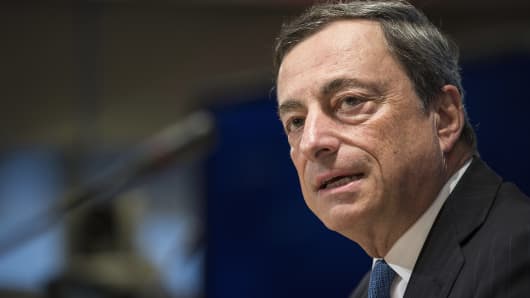The European Central Bank's plan to, along with each member country's central bank, launch a $1 trillion bond-buying program raises as many questions as it answers.
The most important of which is not whether it will boost European Union growth and inflation, but whether it will create an unexpected problem, the likes of which the Federal Reserve never need deal.
Will the ECB and individual central banks make or lose money on their bond buys?
Read MoreCNBC survey: Bet on emerging international markets
Remember when the Fed launched its zero interest-rate policy (ZIRP) and the first round of quantitative easing (QE), many said the Fed would take a bath buying both U.S. Treasury bonds and mortgage securities?
The difference was that the Fed, almost by definition, was "buying the bottom" in mortgages, whose prices were so distressed, and the market so illiquid that the Fed could virtually only make money on the transactions. So, too, with Treasurys. The Fed started buying bonds when interest rates were considerably higher and, thus, since the start of QE I, all the way through QE III, the Fed has logged large capital gains on its bond portfolio and remitted back to the Treasury the interest payments from both mortgage securities and Treasury bonds.
However, in the case of the ECB and other individual central banks, they will be buying sovereign debt with yields at historic lows and, as bond math goes, prices at historic highs. In some cases, European bond yields are negative, suggesting that it will be impossible for some of the central banks to ever make money on their QE programs.
Read MoreHistory shows Fed will ease market pain
Rather ironically, QE is designed to bring about lower interest rates, something the Fed's program was quite successful at.
With the exception of Greece, European rates had already greatly discounted the well-telegraphed ECB program, leaving no room for the "shock and awe" that could move markets in a desired direction.
The larger question, which only a handful have thought to ask, is what happens to the central banks if they do, indeed, lose money on their bond buys?
Larger balance sheets, with portfolio losses could reduce the available capital of the individual central banks and the ECB.
Will individual governments be forced to re-capitalize, or bail out the central banks, which are trying to bail out the very countries they are trying to help?
Read MoreOp-ed: The real Deflategate you should be freaking out about
It is a tough question to answer since central banks need not take mark-to-market losses.
They can simply hold the bonds until they mature.
But unlike the Fed, European central banks may face default risk in the peripheral countries of Europe, further complicating an already questionable task.
One has to wonder if QE, at this juncture, is the right tool for Europe. It worked in the U.S. because it was unexpected, unexpectedly large and carried an element of surprise, which shocked markets back to life, much in the same way a defibrillator jolts a heart-attack victim back to life.
For a variety of reasons, the ECB's paddles may not have the same juice in them as the ones used by the Fed.
And while I think European equity markets may move higher as the program nears launch, a failure to resuscitate this moribund patient could spell trouble, not just for the victim, but for the doctors treating him as well.
Commentary by Ron Insana, a CNBC and MSNBC contributor and the author of four books on Wall Street. He also editor of "Insana's Market Intellgence," available at Marketfy.com. He delivers a daily podcast, "Insana Insights," and a long-form weekly version, both available on iTunes and at roninsana.com. Follow him on Twitter @rinsana.



